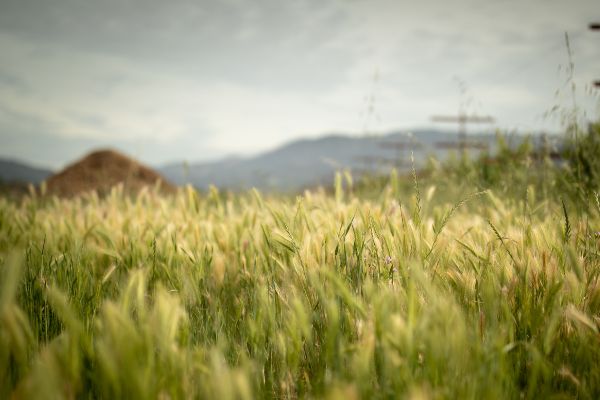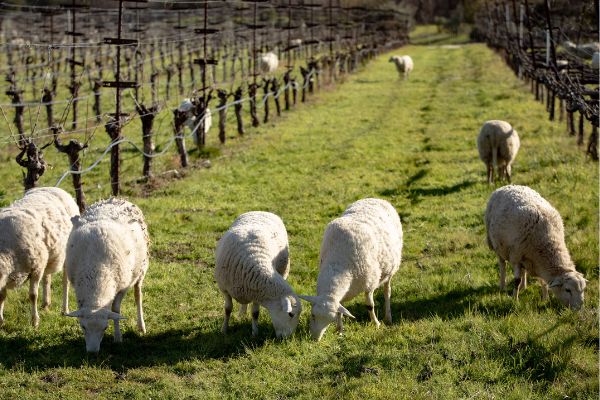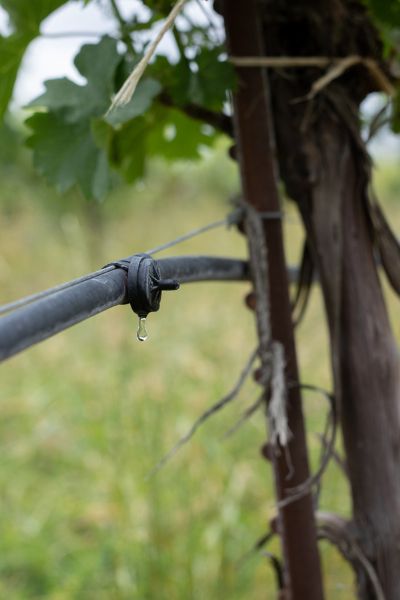Saving water on a vineyard: How we limit our water usage
Like most plants, grapevines need water to grow. But how much? Too much water is wasteful for the environment and results in abundant, but less flavorful fruit. Too little water and the thirsty vines reserve almost all of their energy to keep themselves alive, producing far less fruit.
At Eco Terreno we’ve learned through years of mindful farming practices how to create vineyards that yield outstanding grapes without excessive water use. Not surprisingly, it starts with healthy soil. But equally important are conservation-minded watering practices.
Healthy soil retains water
We dedicate ourselves to year-round practices that bring health to the soil. This includes organic, sustainable, and regenerative farming practices designed to foster naturally nutrient-dense soil. Nutrient-rich soil retains moisture so plants can satisfy their water needs when required, rather than being awash with excess water when they don’t need it.
Cover crops reduce erosion
Along with grapevines, our healthy vineyard soil nurtures a beautiful array of cover crops, including grasses.
Cover crops help bind soil particles together to prevent erosion. They also promote the growth of a natural network of fungal threads called mycelium, which breaks down organic matter into nutrients to be absorbed into the soil.
Meanwhile, our cover crop grasses have mat-like root structures that hold everything in place and protect from the sun’s drying rays. This is especially important for sandy, gravelly soils like those in blocks 15 and 16 and our Sauvignon Blanc blocks at our Cisne Vineyard.

To manage our cover crops and eliminate the need to mow, we graze sheep in the vineyards during the winter months. This is another example of a practice that maintains the health of our soil while minimizing our water usage.

Listening to the vines saves water
By listening to and watching our vines, we’ve learned to understand their states of health and when they need a little water beyond what Mother Nature provides. But we also leverage modern irrigation technology to inform our decisions, keep records of our usage, and water with precision and with minimal waste. With this approach of combining intuition and science, we’re able to conserve our precious water resources.
Drip irrigation only when necessary
Rain doesn’t always visit when the vines need it. Sometimes it doesn’t rain enough, other times it doesn’t rain at the right time. Our natural water retention practices are highly effective and take fluctuations into account, but on occasions, it’s necessary to irrigate. In such cases, we use drip irrigation to water all vines, which decreases the potential of evaporation and sends water only where it’s needed.

Moisture sensors for real-time data
Supporting our drip system are soil moisture-probes located throughout the vineyards. These allow us to understand our soil moisture content and how much water our vines need in real time. We also employ what’s known as a pressure chamber, which checks the “pulse” of our vines to understand their immediate water needs; we base irrigation decisions on the results.
Storing excess water for future use
Located on the Cisne Vineyard is our irrigation pond. Built to capture the excess rainfall runoff, it provides a sustainable source of water for that site’s vineyard blocks and our fruit trees in the orchard. It’s another way for us to adapt to precipitation’s fluctuations, storing water in times of abundance, for slow distribution in times of dryness.
Always looking for improvements
For our peace of mind and our mission to farm in harmony with nature, we conduct internal water reviews yearly and external water reviews every three years. Partnering with Sonoma County Restoration Conservation District, we run water efficiency tests on our irrigation system to make sure everything is working properly and we are using only as much water as the vines and farm requires.
Water management is something we work at every day. We consider it our responsibility to continue to lead the charge in responsible vineyard farming, so we’re forever seeking and implementing the latest in water-conservation practices. And that’s just fine with us. It’s the least we can do for our beautiful patch of California land, our local and global community, and our collective greatest asset, Mother Earth.
What is the average annual rainfall of the Alexander Valley?
Alexander Valley experiences a moderate Mediterranean climate, with defined wet and dry seasons. Approximately ninety percent of the rainfall occurs between November to April. The mean annual precipitation for Healdsburg, the largest town in the Alexander Valley, is about 42 inches per year, according to US Climate Data. At Eco Terreno our rainfall averages for the year were significantly below this number, wildly fluctuating from year to year, even from vineyard site to vineyard site. The last three years we have received the following rainfall:
- In 2019: 31.6 inches at Lyon and 21.8 at Cisne
- In 2020: 9.8 inches at Lyon and 7.5 at Cisne
- In 2021: 23 inches at Lyon and 21.8 at Cisne
As you can see, even in the last three years, rainfall has not occurred reliably or consistently. For this reason we must and should adopt as many natural practices as possible to conserve one of our most valuable resources, our water.
Do vineyards use a lot of water?
According to the California Department of Water Resources data, vineyards use significantly less water in comparison to many other crops. At almost twice the usage are almonds and pistachios, followed closely by citrus such as grapefruit, lemons, and oranges. The list goes on, with sugar beets, nectarines, peaches, cherries, apples, pears, figs, onions, and garlic much thirstier on average than vineyards. But this doesn’t mean we don’t try to do better.
As organic and regenerative farmers, our water usage is closely monitored and we use only the bare minimum, to maintain healthy vines, grow produce, and keep our animals hydrated.
How to save water at home – 5 easy tips to start today.
The EPA (Environmental Protection Agency) estimates the average home uses more than 300 gallons of water per day, 109,500 per year. Seventy percent is used indoors, these being the top 4 ways – toilet, shower/bath, faucet, clothes washer. A very concerning amount of water is wasted through leaks, at around 12 percent of total usage. With this data in mind, here’s a list of ways to save water easily and immediately. And a bonus one for saving water outdoors!
1. Repair a leaky fauce
It’s possible this could save 10,000 gallons of water per year simply by repairing a faucet or replacing it. Imagine the money this saves you too!
2. Stop toilet leaks
Toilets use the most water which means fixing a leak could be the fastest way to save water. Even a slow leak wastes on average 30 gallons a day, 10,950 gallons a year. An easy test to check for a toilet leak is with food coloring. Put a few drops in your toilet tank and if the color appears in the bowl without flushing, you have a leak. The solution could be as simple as replacing an old toilet flapper which should be replaced every 5 years anyway.
3. Reduce your showers to 5 minutes.
The average shower time is 8.2 minutes. By reducing it to 5 minutes most days you’ll save on average 7.5 gallons of water a day, 2,737 gallons per year. Do this easily by setting the timer on your phone (but remember to keep your phone out of the water…).
4. Turn off your tap while brushing your teeth.
According to a study conducted by the EPA, leaving the water running while brushing your teeth wastes an average of 4 gallons each time, 8 gallons a day. You can reduce that to approximately 1 gallon each time, saving 2,190 gallons a year. Turn it on to wet the brush then instantly turn it off again, until you’ve finished brushing and need to wash your toothpaste out.
5. Be water wise in your garden.
Select native plants as they tend to require less water. If you do need to water your garden, do so in the early morning to prevent evaporation. And install low-flow drip emitters instead of sprinklers. Drip irrigation greatly reduces your water wastage as the water is better directed to where it’s actually needed.
These 5 water saving tips alone could save you just over 25,000 gallons of water wastage a year. That’s about a quarter of your total water usage saved without too much effort!
For more tips, refer to the EPA WaterSense program.
Read more about life on a regenerative wine farm
Learn about our farming practices
Regenerative Wine Farming: What it is and why it matters to our farm and the earth
